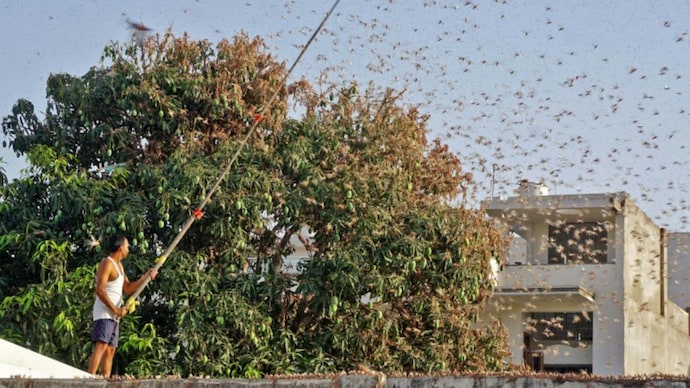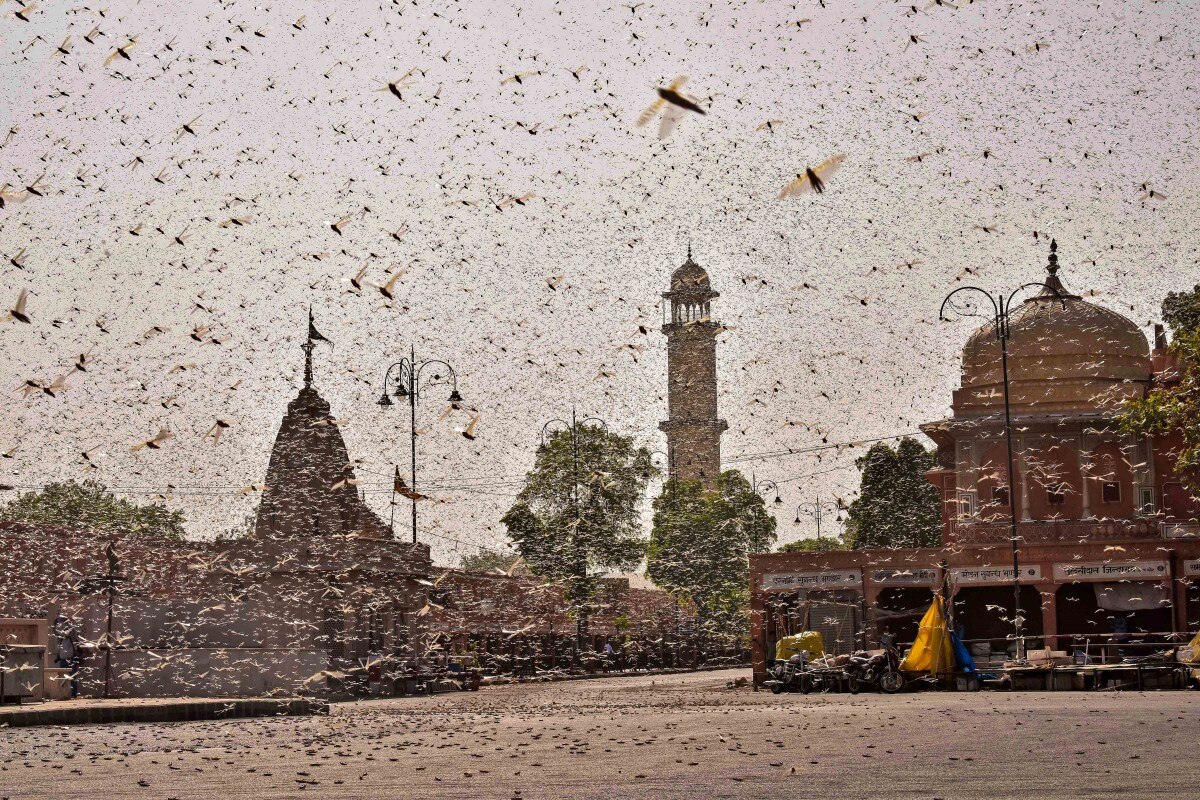Panic in Mumbai to alert in Delhi: Locusts ravage Rajasthan, more invasions predicted
The locusts, which arrived late last year into Rajasthan from Pakistan, have affected thousands of farmers in several states in northern and central India.

Already crippled by a dwindling economy besieged by the coronavirus pandemic, millions of swarming locusts ravaging their crops is the worst nightmare farmers in North India could have possibly had. But it has turned out to be true.
Farmers in Rajasthan, Punjab, Madhya Pradesh, Gujarat and Maharashtra are in the midst of the worst locust attack in the last 27 years.
The locusts, which arrived late last year into Rajasthan from Pakistan, have affected thousands of farmers in several states in northern and central India.
Authorities in Delhi, Haryana, Himachal Pradesh, Telangana and Karnataka too sounded alerts Thursday to the possibility of locusts entering their territories while United Nation's Food and Agriculture Organisation (FAO) has warned that the pests could reach as far east as Bihar and Odisha in the coming weeks.
What is locust attack
India is battling the worst desert locust outbreak in recent times. According to experts, broadly four species of locusts are found in India desert locust, migratory locust, Bombay locust and tree locust. The desert locust is considered the most destructive.
It multiplies very rapidly and is capable of covering 150 kilometers in a day.
This insect, a type of grasshopper, can eat more than its body weight. A one square kilometer of locust swarm containing around 40 million locusts can in a day eat as much food as 35,000 people.
Experts blame the growing menace of desert locusts on climate change. They say breeding of locusts is directly related to soil moisture and food availability.
States stung by locust attack
Hundreds of millions of locusts, in what has been a fresh attack on Monday, flew over large swathes of land in Rajasthan from where they reached bordering regions of Madhya Pradesh, Punjab, Gujarat and Maharashtra.
Locusts have already destroyed crops spread over at least 90,000 hectares of land, mostly in western and eastern Rajasthan. The districts adversely affected by the largescale attacks by locusts include Sri Ganganagar, Jaisalmer, Barmer, Bikaner, Jodhpur, Churu and Nagaur, Ajmer, Jaipur and Dausa. The dreaded locust attack has not spared Rajasthan's capital as millions of locusts were seen swarming over Jaipur on Monday.

Om Prakash, commissioner at the state’s Agriculture Department, on Thursday, said that the department carried out locust control operations over 67,000 hectares in Rajasthan.
In Uttar Pradesh, agriculture department workers targeted swarms in Moth and Garautha areas of Jhansi, and in Sonbhadra district overnight, according to Kamal Katiyar Deputy Director, Agriculture.
In Sonbhadra, a swarm Wednesday reached Bemauri village in Ghorawal tehsil, where a team from the Agriculture Department sprayed chemicals till late night, killing a large number of insects.
There was little damage as there are no standing crops right now, District Agriculture Officer Piyush Rai said.
Several other UP districts remain on alert.
Swarms crossed into Madhya Pradesh’s Balaghat district from eastern Maharashtra on Thursday afternoon, an official said. Shivpuri district in MP is also adversely affected due to the locust attack.
According to Dr Ravi Chapre of the Locust Warning Organisation of the Government of India, who is based in Indore, a few small swarms are right now active in MP's Hoshangabad and Katni and they are being neutralised.
The pests were sighted over Sondya village in Tumsar tehsil of Maharashtra’s Bhandara district around 1 pm, Ravi Bhosle, Divisional Joint Director at the state’s Agriculture Department said.
The locusts then crossed the Bawanthadi river, reaching Balaghat.
"Our staff in the border area is keeping a watch on the locust movement in case they re-enter Maharashtra," he said.
A Maharashtra agriculture department team had rushed to Temani village in Bhandara district in the early hours of Thursday and sprayed pesticides from two fire tenders on trees over a one-kilometre radius.
“Pesticides were sprayed and by morning, a large number of them had fallen off the trees and died," Bhosle said.
"Mango trees were affected the most. They devoured leaves but not the fruit. Also, no damage was seen in paddy fields," he said.
Palghar district authorities too have asked farmers to be on alert.
Several states on alert
Swarms of locusts may have been limited to five states geographically for now, but these insects can fly up to 150 km a day in the direction of the wind speed. This, along with the FAO warning on their possible inward march India, has forced several states to sound an alert and asked their farmers to stay prepared.
Alerts have been sounded in Delhi, Haryana, Himachal Pradesh, Telangana and Karnataka.
The Delhi government has asked authorities concerned to spray insecticides and pesticides on standing crops, vegetation, gardens and orchards to prevent a probable attack of desert locusts in Delhi.
Agriculture Department Joint Director AP Saini in an advisory issued on Wednesday asked the authorities to organise awareness programmes for the public and farmers to prevent the attack of locusts in the national capital.
Haryana government has put its anti-locust machinery on stand by. “We are ready. Seven districts have been put on high alert,” Sanjeev Kaushal, Additional Chief Secretary at Haryana’s Agriculture and Farmers’ Welfare Department told PTI.
Karnataka set up a committee to examine the threat while saying that the chances of the insects flying into the state are remote.
However, Himachal and Telangana have issued alerts to their farmers.
Telangana government Chief Minister K Chandrasekhar Rao on Thursday held a meeting with officials and scientists on the issue of locust swarms and directed the concerned departments to be ready to face a locust attack. The state is monitoring a possible movement of locust via its borders with Maharashtra and Chhattisgarh.
Fire engines, jetting machines and pesticides have been kept ready as part of measures to deal with the situation, an official release said.
Meanwhile, Himachal Pradesh a high alert for four districts - Kangra, Una, Bilaspur and Solan. The state Agriculture Director R K Koundal stated that a massive swarm of desert locust has been destroying crops in adjoining states and may spread to Himachal Pradesh.
Field functionaries have been alerted to keep continuous and constant vigilance on locust activity and get ready to control any locust emergency situation, he added. Farmers have been asked to report any activity of locusts to nearby agriculture officers, he added.
Videos of 'locusts' in Mumbai go viral, officials debunk claim
Even as the state authorities assured that the locust swarms have reached only border districts, people in Mumbai panicked as videos of locusts swarms in the city went viral on social media. The videos claimed swarms of locusts flying over northern India had entered Mumbai, which is already battling a severe outbreak of coronavirus.
The viral videos forced authorities to clarify that no such activity took place in Mumbai.
One such video shot from a building showed a ‘locust swarm’ with a skyline that appeared to be of Mumbai.
“The locusts have landed! Welcome to Mumbai, locustji. Feel free to mingle with our political pests...,” columnist Shobhaa De tweeted.
Locusts headed towards Mumbai.
Plus, there is a cyclonic warning.
Yaaaaay....things can only get better after we survive all this..
and Covid-19. — Shobhaa De (@DeShobhaa) May 27, 2020
Actress Neeetu Chandra informed in a tweet that her aunt staying in Colaba area had sent her a video of a swarm of locusts in the south Mumbai area.
Hey guys, #locust have reached #Mumbai #Maharastra My aunt, staying in Kolaba sent me this video
Please shut your windows too... If they are not letting you go out, you don't let them come in too #Locustsattack pic.twitter.com/vjbLud8x7C — Neetu Chandra Srivastava (@Neetu_Chandra) May 28, 2020
Maharashtra state disaster management officials said no locust swarm was spotted in Mumbai. “The viral images and videos have been wrongly attributed as being from Mumbai,” an official said.
Locust hitting #Mumbai today#LocustAttack pic.twitter.com/WfAi2JnLEi — Rajan (@MissdOportunity) May 28, 2020
Long battle ahead
The FAO has warned that the invasion could continue for weeks. "Several successive waves of invasions can be expected until July in Rajasthan with eastward surges across northern India as far as Bihar and Odisha, followed by westward movements and a return to Rajasthan on the changing winds associated with the monsoon," it said.
In the past few days, there have been movements of adult groups of locusts in India, Oman, the UAE, and Uganda, it said.
Swarms are forming in the spring breeding areas and migrating east to the Indo-Pakistan border ahead of the monsoon rains.
FAO Director-General Qu Dongyu had on May 22 warned that efforts to control desert locusts will take time.
"Our gains have been significant, but the battle is long and is spreading to new areas. It is clear that we cannot declare victory yet. Upsurges of this magnitude are rarely defeated in a few months," he said.
In the coming months, desert locusts will continue breeding in Ethiopia, Kenya and Somalia. New swarms will form in June and migrate to Sudan through South Sudan and pose a risk to the Sahel in West Africa.
"The locusts, combined with the impacts of COVID-19, could have catastrophic consequences on livelihoods and food security," the FAO head said.
Thousands of farmers fear that their plans of sowing summer crops such as cotton, corn and rice may receive a massive jolt because of the onslaught by these swarming locusts.
Centre plans to spray chemicals via drones, helicopters
Union Agriculture Minister Narendra Singh Tomar on Thursday held a high-level meeting to review locust control operations.
An official statement about the meeting said that India has currently deployed 47 spray equipment and 200 officials to control the locust menace. “Beyond scheduled desert areas, temporary control camps have also been set up at Jaipur, Chittorgarh, Dausa in Rajasthan; Sheopur, Neemuch, Ujjain in Madhya Pradesh and Jhansi in Uttar Pradesh for locust control,” the statement said.
As per the Centre, the locust has been controlled in an area of about 50,468 hectares in 334 locations in Rajasthan, Punjab, Gujarat and Madhya Pradesh.
To further up the ante against the advancing locust the Centre is planning to procure additional sprayers from the UK.

“Fifteen sprayers will start arriving from Britain in the next 15 days. Besides, 45 more sprayers will be procured in a month or one-and-a-half months. Drones will be used to spray pesticides on tall trees and inaccessible places for effective control of locusts, while plans are afoot to deploy helicopters for aerial spray,” it said.
The agriculture minister said that 11 regional control rooms have been established and special contingents have been deployed along with additional manpower to check the spread of locusts. He assured the affected states will be allocated additional resources and financial aid if required.
The Centre is in close touch with the affected states and an advisory has been issued, he said.
Presently, pink swarms of immature adults are being reported in India which is very active and mobile and it is difficult to control them in one place; however, it takes require at least 4 to 5 days of control at different locations for the complete elimination of the locust population in one flock. Enough stock of pesticides is available with the locust control organization, the Centre has said.
(With inputs from Himanshu Mishra In Delhi, Dev Ankur Wadhwan in Jaipur, Hemender Sharma in Bhopal, Pankaj Khelkar in Pune and agencies)
